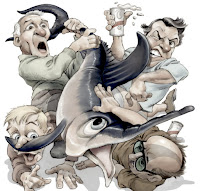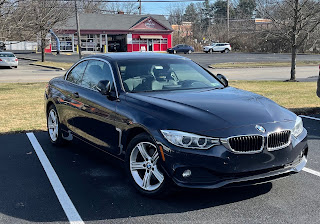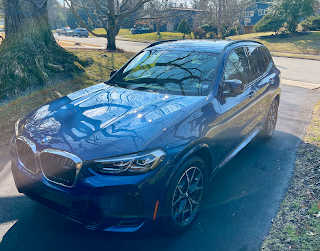The people who share our pastimes

Image credit: Steve Haefele in Salt Water Sportsman
I enjoy fishing alone, and I enjoy fishing with friends and neighbors. Alone can be quiet and peaceful and an escape from the noise of the world, while fishing with others is not only social, but practical. Fishing with buddies means more hands when we need someone at the wheel and someone on the landing net or tending an anchor. Fishing with a buddy or two is also a great opportunity to share knowledge. We talk about what bait, lure, tackle, or technique has worked well lately, and what spots have surprised us in recent days in good or bad ways. We might share what we’ve seen in the water that might affect fishing, like big schools of sand eels or bunker.
It’s great to have fishing buddies! Even when neighbors and I fish alone, we often end up comparing notes at the end of the day as we clean the boats. When my neighbors bring their boats back to the dock after a day of fishing and I’m already at my dock, I’ll walk over and offer to hand them a dock line to make things a little easier and then we’ll talk about their day.
Recently, I had the chance to expand my thinking on who "counts" as a fishing buddy.
A few days ago I did my start of season fishing gear inventory and cleanup. I dragged out all my tackleboxes and gear from my fishing shed, pulling the tackle out and cleaning the boxes and then reorganizing the tackle back into the boxes, throwing away a few old rigs that aren’t going to make another season. I cleaned up lures and hooks, replacing rusty treble hooks on topwater plugs I’ll need for spring Striped Bass. When I was done, I had a short list of fishing supplies needed, so I headed into town.
I pulled into the parking lot of the tiny neighborhood tackle shop I’ve been going to for the last 15 years, and as I entered the shop for the first time this season, I saw Tom who has run the place for the owner, his brother Pete, since the shop opened. I’ve known Tom since the shop opened. He and his shop have been a great source for fishing equipment, advice and help, and on what’s biting and where in our local waters. Over the years we’ve gotten to know each other and become friendly. Tom is really another fishing buddy, even though we’ve never actually fished together. He greets me by name with a smile, he knows what I fish for, and he knows some of my preferences on fishing equipment. I appreciate his help and advice and have many times chosen to buy rods and reels from him rather than save a few bucks at a giant chain store or an online supplier. I like my local shop to thrive and stay in business, and I appreciate that they give me the kind of personalized help a local shop provides.
Once, a few years ago, I brought in a very old Penn conventional reel that had some problems. It was very old and it wasn’t a high quality reel. I could have thrown it away, but it had some sentimental value for me. When my mom fished from time to time with my dad and me years ago, she used that reel most of the time. I had managed to keep it working for decades, but now repair was beyond me so I took it in to have Tom work on it. When he gave it back to me a week later it was working well and as part of the repair he explained that he had to replace the handle and showed me how it worked smoothly with the new one. Then he handed me something. It was the old handle on a key ring. He had welded a loop to attach it. He said, “Since it was your mom’s reel, I though you might like to keep that handle so I made a key ring for it.” I was really touched by this. I still have that key ring and keep the key to my fishing shed on it.
Anyway, back to present day. When I entered the tackle shop and saw Tom, we caught up on our winters and shot the breeze for a few and then he said, “I’m really glad you stopped in today. Tomorrow’s my last day and I’m saying goodbye to the friends I’ve made here. We are moving out of the area and starting a new life.” Tom had gotten married last fall and he and his new wife wanted to move to an area where they could afford to get a house and some land, and Long Island was not a place to do that affordably.
I wished my fishing buddy well and shook his hand telling him how I really appreciated him and that I hoped our paths would cross again. I told him I valued his help and advice, and his friendship over the years. I’d miss him and I said so. He smiled and said he’d miss my visits to the shop.
Lifelong fisherman like myself have lots of fishing buddies. They enter our lives, and sadly sometimes they depart. I first fished as a 5-year-old with my father, grandfather, and uncles. Sometimes my mother and my aunt would join us. These family members who taught me to love fishing are all gone now, but were my first fishing buddies. Now I fish often with my sons, and I’ve taught them what I know. These days I also fish with my neighbors and with friends from my school days. All of these people have been my fishing buddies.
Thanks to all my fishing buddies, past, present and future. You make my time spent fishing that much better!
Thanks for reading! A blog works best with active participation. If you enjoy this blog, leave a comment, tell others about it, and share a link to it on your favorite social network. More readers will drive more discussion.









